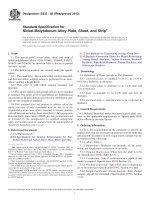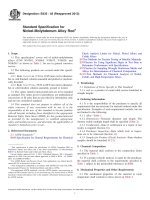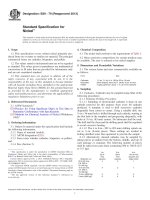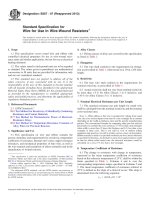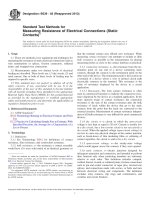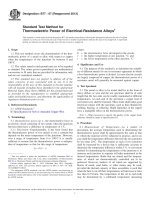Astm b 77 07 (2013)
Bạn đang xem bản rút gọn của tài liệu. Xem và tải ngay bản đầy đủ của tài liệu tại đây (65.2 KB, 2 trang )
Designation: B77 − 07 (Reapproved 2013)
Standard Test Method for
Thermoelectric Power of Electrical-Resistance Alloys1
This standard is issued under the fixed designation B77; the number immediately following the designation indicates the year of original
adoption or, in the case of revision, the year of last revision. A number in parentheses indicates the year of last reapproval. A superscript
epsilon (´) indicates an editorial change since the last revision or reapproval.
1. Scope
where:
E = the electromotive force developed in the circuit,
t' = the higher temperature at one junction, °C, and
t = the lower temperature at the other junction, °C.
1.1 This test method covers the determination of the thermoelectric power of a metal or alloy with respect to copper
when the temperatures of the junctions lie between 0 and
100°C.
4. Significance and Use
1.2 The values stated in inch-pound units are to be regarded
as standard. The values given in parentheses are mathematical
conversions to SI units that are provided for information only
and are not considered standard.
1.3 This standard does not purport to address all of the
safety concerns, if any, associated with its use. It is the
responsibility of the user of this standard to become familiar
with all hazards including those identified in the appropriate
Material Safety Data Sheet (MSDS) for this product/material
as provided by the manufacturer, to establish appropriate
safety and health practices, and determine the applicability of
regulatory limitations prior to use.
4.1 The purpose of this method is to determine the suitability of different metals for use in resistance apparatus in which
a low thermoelectric power is desired. As most electric circuits
are largely composed of copper, the thermoelectric power of a
resistance metal will generally be measured against copper.
5. Test Specimen
5.1 The metal or alloy to be tested shall be in the form of
sheet, ribbon, or wire and the test specimen shall be of such
length that the two ends can be readily maintained at different
temperatures. At each end of the specimen a copper lead of
convenient size shall be fastened. These leads shall make good
electrical contact with the specimen, such as that obtained by
welding, brazing, or soldering. Slight impurities in the copper
have a negligible effect on the thermoelectric power.
2. Referenced Documents
2.1 ASTM Standards:2
B3 Specification for Soft or Annealed Copper Wire
NOTE 1—When necessary to specify the quality of the copper leads,
reference should be made to Specification B3.
3. Terminology
3.1 thermoelectric power, Q, n—the electromotive force in
an electric circuit consisting of two metals when the junctions
between them have a difference in temperature of 1°C.
3.1.1 Discussion—Experimentally, it has been found that
the thermoelectric power of two metals is not a constant but
depends on the mean temperature of the junctions. However,
over a range of temperature from 0 to 100°C it is usually
sufficient to assume that the thermoelectric power is independent of temperature so that for this range of temperature:
6. Procedure
6.1 Measurement of Temperature—As a matter of
precaution, the average temperature used in determining the
thermoelectric power shall be approximately the same as that
to which the material will be subjected in practice, and in no
case shall the temperature difference between the two junctions
be less than 20°C. The temperature at each of two junctions
shall be measured by a device that is sufficiently accurate to
determine the temperature difference within 5 %. A convenient
method for determining the temperatures of the junctions is to
immerse each junction in separate oil baths maintained at the
desired temperatures. Baths that are stirred and the temperatures of which are thermostatically controlled are to be
preferred. However, beakers of oil which are supported by
blocks of metal, sand baths, or other means may be used,
provided the thermal capacity of these assemblies is such that
when the heat is cut off their temperatures will decrease at rates
less than 0.2°C/min. The temperature of the oil in each bath
may be determined by a calibrated temperature measuring
Q 5 E/ ~ t'2t !
1
This test method is under the jurisdiction of ASTM Committee B02 on
Nonferrous Metals and Alloys and is the direct responsibility of Subcommittee
B02.10 on Thermostat Metals and Electrical Resistance Heating Materials.
Current edition approved May 1, 2013. Published May 2013. Originally
approved in 1930. Last previous edition approved in 2007 as B77 – 07. DOI:
10.1520/B0077-07R13.
2
For referenced ASTM standards, visit the ASTM website, www.astm.org, or
contact ASTM Customer Service at For Annual Book of ASTM
Standards volume information, refer to the standard’s Document Summary page on
the ASTM website.
Copyright © ASTM International, 100 Barr Harbor Drive, PO Box C700, West Conshohocken, PA 19428-2959. United States
1
B77 − 07 (2013)
metal or alloy, the direction of current flow in the metal or alloy
is from the junction having the higher temperature to the one
having the lower temperature.
device of suitable precision and accuracy. If the oil is not
stirred, the junctions shall be placed in close proximity to the
temperature-measuring instrument. To ensure that the temperatures of the junctions shall not be influenced by heat of
conduction along the specimen, the length of each specimen
from the junction to the point where it leaves the surface of the
oil shall not be less than 10 times the minimum cross-section
dimension of the resistance material, nor less than 100 times
the minimum cross section of the copper leads, and in no case
less than 2 in. (50.8 mm).
8. Report
8.1 The report shall include the following:
8.1.1 The character of the metal or alloy tested and the
identification of the specimen,
8.1.2 The size, shape, and length of the specimen,
8.1.3 Method of determining the temperatures of the
junctions,
8.1.4 The temperature at each junction in degree Celsius,
8.1.5 The type of apparatus used in measuring the electromotive force,
8.1.6 The observed electromotive force,
8.1.7 The thermoelectric power, and
8.1.8 The polarity of the metal or alloy tested.
6.2 Measurement of Electromotive Force—The electromotive force shall be determined by a method that will give the
value correct within 5 %. Three different methods of measuring
the electromotive force are in common use, namely:
6.2.1 The method in which a potentiometer is used to
compare the unknown emf with that of a standard cell.
6.2.2 The method in which the unknown emf is equated to
the difference of potential between the terminals of a standard
resistor when a measured current flows through it.
6.2.3 The method in which the emf is measured by the
deflection of a suitable measuring instrument.
6.2.4 In any case, precautions shall be taken to ensure that
there are no parasitic electromotive forces in the measuring
circuit, a condition which may be determined by placing both
junctions in the same beaker, in which case no appreciable
electromotive force shall be indicated.
9. Precision and Bias
9.1 The reproducibility of the test results depends on the
control used in making the connections and the control of
temperatures at the junctions. The bias will depend on the
parameters listed for reproducibility and instrumentation used
to measure emf.
9.2 The precision of this test method should be 1 % or less.
9.3 The bias of this test method is within 6 %.
7. Polarity of the Metal
10. Keywords
7.1 The metal or alloy tested shall be considered to have
positive polarity when, in a circuit consisting of copper and the
10.1 copper; electrical resistant alloys; potentiometer; thermoelectric power
ASTM International takes no position respecting the validity of any patent rights asserted in connection with any item mentioned
in this standard. Users of this standard are expressly advised that determination of the validity of any such patent rights, and the risk
of infringement of such rights, are entirely their own responsibility.
This standard is subject to revision at any time by the responsible technical committee and must be reviewed every five years and
if not revised, either reapproved or withdrawn. Your comments are invited either for revision of this standard or for additional standards
and should be addressed to ASTM International Headquarters. Your comments will receive careful consideration at a meeting of the
responsible technical committee, which you may attend. If you feel that your comments have not received a fair hearing you should
make your views known to the ASTM Committee on Standards, at the address shown below.
This standard is copyrighted by ASTM International, 100 Barr Harbor Drive, PO Box C700, West Conshohocken, PA 19428-2959,
United States. Individual reprints (single or multiple copies) of this standard may be obtained by contacting ASTM at the above
address or at 610-832-9585 (phone), 610-832-9555 (fax), or (e-mail); or through the ASTM website
(www.astm.org). Permission rights to photocopy the standard may also be secured from the ASTM website (www.astm.org/
COPYRIGHT/).
2

